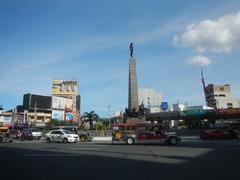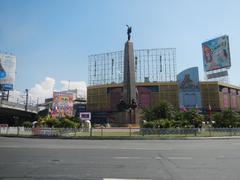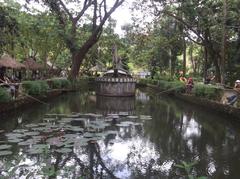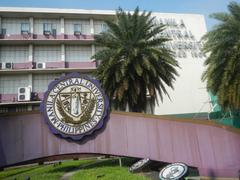
Bonifacio Monument: Visiting Hours, Tickets, and Travel Guide in Caloocan, Philippines
Date: 15/06/2025
Introduction
The Bonifacio Monument, locally known as “Monumento,” is a nationally significant landmark located at the heart of Caloocan City, Metro Manila. Erected in honor of Andrés Bonifacio, the “Supremo” of the Katipunan and a central figure in the Philippine Revolution against Spanish colonial rule, the monument stands as a stirring symbol of Filipino patriotism, unity, and resilience. Designed by National Artist Guillermo Tolentino and unveiled in 1933, the monument is not only an artistic masterpiece but also a living heritage site that continues to inspire civic pride and national consciousness (Vigattin Tourism; National Commission for Culture and the Arts; Tribune.net.ph, 2025).
This comprehensive guide covers the monument’s historical background, artistic features, practical visitor information (including hours, ticketing, and accessibility), nearby attractions, and expert tips to help you make the most of your visit.
Table of Contents
- Historical Background
- Monument Features and Symbolism
- Location and Accessibility
- Visiting Hours and Ticket Information
- Travel Tips and Best Times to Visit
- Nearby Attractions and Amenities
- Events and Community Activities
- Preservation and Heritage Status
- Frequently Asked Questions (FAQs)
- Conclusion
Historical Background
Origins and Purpose
The Bonifacio Monument was conceived to honor Andrés Bonifacio’s legacy as the leader of the Katipunan and a champion of the 1896 Philippine Revolution. The idea gained momentum in the early 20th century, culminating in Act No. 2946 (1921), which declared November 30 as Bonifacio Day, and Act No. 2760 (1918), authorizing the construction of a national monument (Vigattin Tourism).
Design and Construction
A national competition in 1930 selected Guillermo Tolentino’s design, which fused classical, romantic, and Filipino elements. Construction began in 1929 and was completed in time for the monument’s unveiling on November 30, 1933, Bonifacio’s birth anniversary (Cultural Center of the Philippines). The monument anchors the site of key revolutionary activities and remains an enduring symbol of national identity (TravelAsker).
Monument Features and Symbolism
- Central Figure: Bonifacio is shown in mid-stride, wielding a bolo and a revolver, symbolizing the dual nature of the revolution—rooted in tradition and open to modernity (Official Gazette).
- Surrounding Figures: Twenty-two life-sized bronze figures represent the Filipino masses—workers, peasants, women, and youth—emphasizing collective action.
- Obelisk: The central obelisk rises above the ensemble and is topped by a winged figure symbolizing victory and hope (Philippine News Agency).
- Base Reliefs: These depict key revolutionary moments, such as the “Cry of Pugad Lawin,” when Katipuneros tore their cedulas in defiance (Philippine Daily Inquirer).
- Octagonal Base: Represents the eight provinces first to revolt against Spanish rule, echoing the sun’s rays in the Philippine flag (manilastandard.net).
- Three Steps: Symbolize the 333 years of Spanish colonial rule (manilastandard.net).
The entire structure, standing 13.7 meters tall, is constructed from bronze (for the sculptures) and granite (for the pedestal), using the lost-wax casting method for durability (NCCA).
Location and Accessibility
The monument sits at the intersection of Samson Road, MacArthur Highway, Rizal Avenue Extension, and EDSA. This area, referred to as “Monumento,” is a major urban gateway and a hub for civic life in Caloocan (wikipedia; morefunwithjuan.com).
Getting There
- By LRT: Alight at Monumento Station (LRT-1), a short walk away.
- By Bus/Jeepney: Routes from across Metro Manila pass through Monumento Circle.
- By Car: Parking is available at nearby establishments, though public transport is recommended due to traffic.
The monument is wheelchair accessible, with paved walkways and ramps. The area is generally safe but can be crowded and noisy due to heavy urban activity (hikersbay.com).
Visiting Hours and Ticket Information
- Hours: Open daily from 6:00 AM to 6:00 PM.
- Admission: Free of charge (traveloka.com).
While technically accessible 24/7, daylight visits are recommended for safety and visibility.
Travel Tips and Best Times to Visit
- Best Months: November to February offers cooler weather (touristplaces.guide).
- Special Occasions: Bonifacio Day (November 30) and Independence Day (June 12) feature ceremonies and parades.
- Photography: Early morning or late afternoon provides the best lighting for photos. Be cautious near traffic.
Guided tours are occasionally offered by heritage groups such as Renacimiento Manila (propertyreport.ph).
Nearby Attractions and Amenities
- Museo ng Katipunan: Exhibits artifacts from the revolutionary era (trek.zone).
- Caloocan Cathedral: Historic church dating back to the 17th century (touristplaces.guide).
- Monumento Circle: Bustling shopping and food district (trek.zone).
- Local Cuisine: Sample Filipino snacks such as bibingka and suman at nearby stalls.
Accommodation: Nearby hotels include Hotel 99 Monumento, Astrotel Monumento, and Victoria Court Malabon (hikersbay.com).
Events and Community Activities
The Bonifacio Monument is the focal point for major civic and national events, including the annual Bonifacio Day and Independence Day celebrations (Tribune.net.ph, 2025). These events feature wreath-laying ceremonies, parades, and cultural performances, reinforcing the monument’s role as a hub for patriotism and community engagement.
Preservation and Heritage Status
The Bonifacio Monument is designated as a National Cultural Treasure and is protected by law from alteration or relocation (artesdelasfilipinas.com). Regular restoration projects ensure the monument’s structural integrity and aesthetic appeal (ABS-CBN News).
Frequently Asked Questions (FAQs)
Q: What are the Bonifacio Monument’s visiting hours?
A: Open daily from 6:00 AM to 6:00 PM.
Q: Is there an entrance fee?
A: No, admission is free.
Q: How do I get there?
A: Take the LRT-1 to Monumento Station, or use any bus/jeepney route passing through Monumento Circle.
Q: Are guided tours available?
A: Yes, through the Caloocan tourism office or heritage groups.
Q: Is the site wheelchair accessible?
A: Yes, though crowds and urban conditions may present some challenges.
Q: When is the best time to visit?
A: November to February for cooler weather; Bonifacio Day for special events.
Conclusion
The Bonifacio Monument stands as a timeless tribute to the Filipino people’s enduring spirit and the revolutionary ideals of Andrés Bonifacio. Its artistic grandeur, historical significance, and accessibility make it a must-visit site for locals and tourists alike. Explore the monument, participate in community celebrations, and immerse yourself in the narrative of Philippine nationhood. For a more enriching experience, consider joining a guided tour or exploring nearby historical and cultural attractions.
Plan your visit today and connect with the legacy of Filipino resilience, unity, and freedom.
Official Sources and Further Reading
- I am a Filipino: The Story Behind Bonifacio Monument, Vigattin Tourism
- Bonifacio Monument, National Commission for Culture and the Arts
- Independence Day in Caloocan, Tribune.net.ph
- Who Created the Sculpture of the Bonifacio Monument in Caloocan?, TravelAsker
- Bonifacio Monument: A Masterpiece of Public Art, Philippine Daily Inquirer
- Bonifacio Monument Gets Makeover, ABS-CBN News
- Bonifacio Monument, Cultural Center of the Philippines
- Bonifacio Monument in Caloocan City, Trek.zone
- Monumento Circle, MoreFunWithJuan
- Shouting in Bronze: The Lasting Relevance of Andres Bonifacio and His Monument, Artes de las Filipinas
- Caloocan Travel Guide: Top 10 Must-Visit Tourist Places, TouristPlaces.Guide
- Travel in Caloocan, HikersBay
- Bonifacio Monument, Traveloka
- Freedom to Explore: Museums and Monuments in Manila, PropertyReport.PH
- Philippine Revolution and Katipunan, PhilippineHistory.PH





